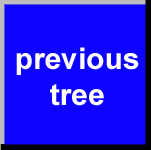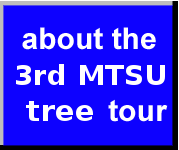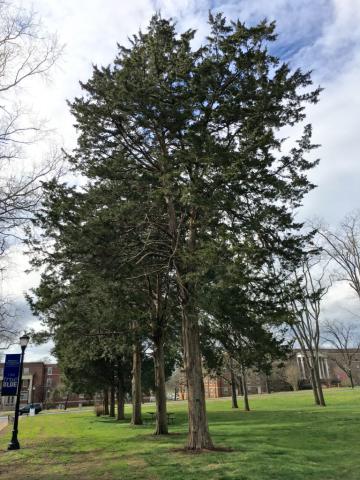
|

|

|

|
An individual instance of Juniperus virginiana (eastern redcedar)

Permanent unique identifier for this particular organism:
http://bioimages.vanderbilt.edu/mtsu/34
Notes:
Description
Juniperus virginiana L., eastern redcedar, is a small evergreen tree, commonly 10 to 40 feet, of pyramidal shape becoming rounder in age. Fruits pale-blue with whitish bloom, fleshy 'berries' (cones), 1/4 inch diameter, ripening the first season, seeds 1 to 2 in each cone, bony-coated; flowers small, cone-like on end of short twigs, male and female borne on separate plants. Leaves opposite, scalelike, covering older twigs closely in alternating pairs to 1/8 inch long, on new shoots awl shaped, sharp pointed and spreading, 1/4 inch long, dark green. Stem single with upright or spreading branches, bark reddish-brown, thin and shreddy, branchlets very slender; roots deep, widely spreading.
Uses
Windbreaks: Plant eastern redcedar in the outer rows of multi-row plantings where it will not be overtopped by taller trees. It can be used in single-row windbreaks when a dense, medium height barrier is desired.
Wildlife: This species provides food and cover for numerous birds and mammals. Winter food and protection is particularly important for pheasant, mule deer and whitetail deer.
Recreation and Beautification: It is suitable for screen plantings. Its year-long coloration and attractiveness to wildlife adds variety to recreational plantings.
Commercial: The wood is aromatic and has insect repellent qualities. It is used to make cedar chests and pencils.
Adaptation and Distribution
It is native to eastern North America, where it occurs strongly on limestone derived soils and is cultivated in Wyoming and Colorado for shelterbelts and ornamental uses below 6,000 feet. This species has a wide distribution and is found on many types of soil ranging from acid sands to those derived from limestone. It does best on dry soils in full sunlight, and is winter hardy and tolerant of droughty and salty soils. Like most junipers, it is very slow growing and is moderately long lived. Eastern redcedar is distributed throughout the east, and lower and upper midwest.
Pests and Potential Problems
It is relatively free of serious insect and disease problems. It is the alternate host for the cedar-apple rust disease which does very little harm to this species but causes serious damage to apples and other pome fruits.
References
USDA NRCS Plant Materials Program (2002). Plant fact sheet for eastern redcedar (juniperus virginiana L.). Retrieved from http://plants.usda.gov/java/factSheet

|

|
|
Load database and switch to thumbnail view
Use this stable URL to link to this page:
http://bioimages.vanderbilt.edu/mtsu/34.htm
This particular organism is believed to have managed means of establishment.
This organismal entity has the scope: multicellular organism.
Identifications:
Juniperus virginiana
L.
sec. Wofford Chester 2002
common name: eastern redcedar
family: Cupressaceae
Identified 2016-03-13 by Patrick Phoebus
Location:
Visitor's Circle, Cope Administration Building, Rutherford County, Tennessee, US
Click on these geocoordinates to load a map showing the location: 35.8466°, -86.3691°
Coordinate uncertainty about: 10 m.
Altitude: 184 m.
Location calculated as average of its images' coordinates.
Occurrences were recorded for this particular organism on the following dates:
2016-03-13
The following images document this particular organism.
Click on a thumbnail to view the image and its metadata. Load database and enable navigation by taxon and organism.
| Image | View |

|
whole tree - general |
|
|
bark - unspecified |
|
|
bark - of a large tree |